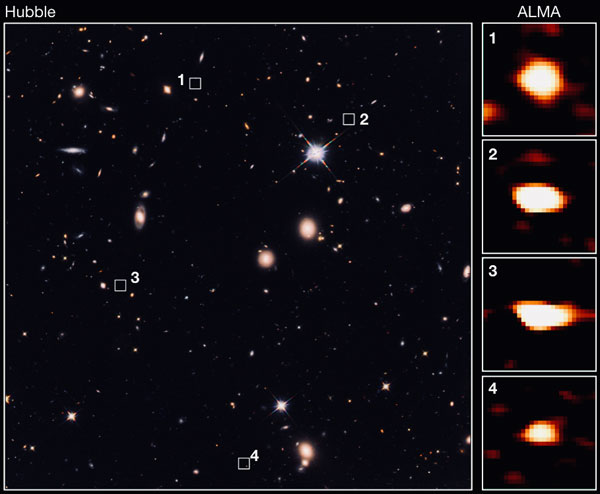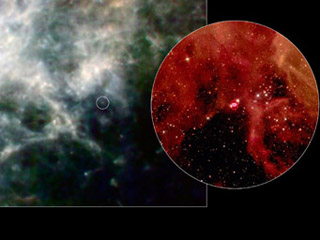“Invisible” Galaxies Found in the Young Universe – Sky & Telescope
Astronomers have discovered galaxies that have escaped detection until now, uncovering a missing link in galaxy evolution. The find suggests that we don’t understand galaxy formation as well as we thought we did.
In deep observations that dig into the earliest eras of the universe, astronomers have excavated the ancestors of modern-day massive galaxies. These dusty galaxies are bursting with stars — but they’re invisible at the wavelengths astronomers typically probe.

ALMA identified 39 faint galaxies that are not seen with the Hubble Space Telescope’s deepest view of the Universe 10 billion light-years away. This example image shows a comparison between Hubble and ALMA observations. The squares numbered from 1 to 4 are the locations of faint galaxies unseen in the Hubble image.
University of Tokyo / CEA / NAOJ
Astronomers have spent years observing a small window of sky with the Hubble and Spitzer Space Telescopes, among other facilities. The survey, dubbed Cosmic Assembly Near-infrared Deep Extragalactic Legacy Survey (CANDELS), samples hundreds of thousands of galaxies at cosmic dawn — when galaxies first appeared — through cosmic noon, when most of the stars we see today formed. Now, a new study published in the August 7th Nature reveals a couple dozen galaxies emitting submillimeter-wavelength radiation. They represent a missing link in galaxy evolution.
Tao Wang (University of Tokyo, French Alternative Energies and Atomic Energy Commission, and the National Astronomical Observatory of Japan) and colleagues focused on 63 infrared-bright galaxies detected in the CANDELS field. Although the Spitzer Space Telescope had detected infrared radiation from these sources, they disappear when viewed through near-visible wavebands. (Specifically, the galaxies go dark beginning with the H-band filter, which is centered at 1,650 nanometers.) Wang and his team observed each galaxy using the Atacama Large Millimeter/submillimeter Array (ALMA) in Chile. They made bank on 39 of them, detecting those galaxies at submillimeter wavelengths.
The ALMA observations show that these optically invisible galaxies are bursting with new stars, forming at roughly 200 times the rate in the Milky Way. But these newborn stars are so heavily shrouded in dust they’re invisible except at very long wavelengths.
That leaves a question, muses Allison Kirkpatrick (University of Kansas), an expert in galaxy evolution who was not involved in the study: Where did all this dust come from?
The Dust’s the Thing

The Herschel Space Observatory and the Hubble Space Telescope imaged Supernova 1987A at longer (left) and shorter (right) wavelengths, respectively. The Herschel image reveals infrared and submillimeter light, showing the dust that formed among the supernova’s remains.
ESA / NASA-JPL / UCL / STScI
The newly discovered galaxies reside in the universe between 1 billion and 3 billion years after the Big Bang, a time between “dawn” and “noon” (a cosmic elevenses, if you will). During this time, star formation was ramping up across the cosmos, and starbirth also means stardeath. Dust forms in the aftermath of supernova explosions but, Kirkpatrick notes, astronomers didn’t think there would have been enough supernovae to produce so much dust so soon.
Since astronomers weren’t expecting dust, they weren’t expecting “invisible” galaxies. Newborn stars are brightest at ultraviolet wavelengths, but the expanding universe will stretch the wavelengths of photons from more distant galaxies. A galaxy might appear bright at optical or even near-infrared wavelengths if it’s far enough away. Regardless, if there’s no dust, then we should be able to see galaxies near and far using just ultraviolet, optical, and near-infrared wavelengths.
Observations at submillimeter wavelengths had turned up galaxies before now, but these had been the extreme stellar factories churning out thousands of stars per year. Those galaxies, while fascinating, are rare. The dim, shrouded galaxies that Wang’s team saw, though, are common enough that they could represent the ancestors of massive, elliptical galaxies that we see in today’s universe.
Results such as this one, though, suggest that the young universe is more dusty than we thought. “This means we do not understand star formation in the early universe,” says Kirkpatrick. “Theory is, as of this paper, based on outdated observations.”
Our understanding of galaxy formation, it seems, is up for major revision.






